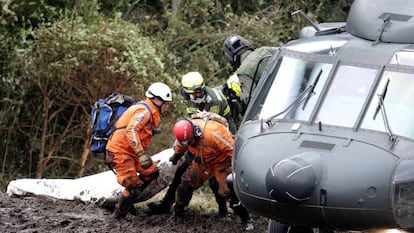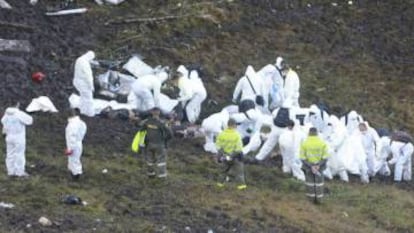A “miracle” amid the tragedy of the Chapecoense air disaster
Six people, two seriously injured, survived tragedy because aircraft did not explode on impact
The six survivors of Monday’s plane crash in Colombia, which killed 71 people, owe their lives to a “miracle”, says Dr. Guillermo León, the head of the San Juan de Dios hospital in La Ceja, the small mountain town from where the rescue operation is being coordinated. Among the six are two players from Brazilian soccer side Chapecoense: Alan Ruschel and Helio Hermito Zampier, along with journalist Rafael Valmorbida.

“It’s a miracle, there’s no doubt about it. It’s highly unusual to survive an accident of this type. Fortunately, there was no explosion, otherwise everybody aboard would have been killed,” he tells the dozens of journalists, most from Brazil, who have descended on the small hospital.
Two other survivors, crew members Erwin Tumiri and Ximena Suárez, are being treated in the larger Sumer Clinic in the nearby town of Rionegro, where Ruschel has been transferred. His teammate Jackson Follmann, Chapecoense’s goalkeeper, is also at the same hospital, in intensive care. He is reported to have had a leg amputated.
Colombia is working with Brazil to speed up the transfer of the documents needed to identify the dead
Nicolás Gutiérrez, a security guard at the hospital in La Ceja’s hospital, says the first injured were brought in around 5.45am on Tuesday morning, some seven hours after the crash occurred in bad weather on Monday night. His daughter is a paramedic and woke him around 11pm when she heard the news. He took her to the hospital, where she joined one of the rescue teams heading up to the rain-lashed La Gorda mountainside where the plane crashed.
“I saw the first injured come in, among them was Helio, I recognized him. He was conscious, he said his name,” he explains, adding that he has not seen his daughter since Tuesday morning.

Representatives from the hospitals treating the survivors and where the remains of the victims have been taken say that they will be putting together teams to help the families who are expected to arrive over the coming days. Carlos Valdés, the director of Colombia’s National Legal Medicine and Forensics Institute, outlined to reporters the procedures to identify the dead, which will be carried out in Medillín, about an hour away from La Ceja by road.
“We have a mortuary with the capacity to deal with this disaster, along with laboratories to help with genetics, fingerprinting, radiology and identification,” he said shortly before leaving for Medellín.
The Colombian authorities are working with the Brazilian government to speed up the transfer of the documents needed to identify bodies. “We need to be able to identify through fingerprinting and hospital and dental records. We are also in direct contact with the federal police in Brazil,” he added.
The first injured were brought in around 5.45am on Tuesday
Medellín’s Legal Medicine Institute begin receiving the first bodies on Tuesday evening, which were taken there directly from the crash site. Autopsies will be carried out and they will be identified by a team of 45 people. Valdés says the process of identifying all the victims should take three days and that families will be able to make arrangements for their repatriation by the weekend.
On Tuesday night, fans and well-wishers gathered to pay homage to the victims of the disaster in Medellín’s Atanasio Girardot stadium, where the first leg of the South American Cup between Chapecoense and local side Atlético Nacional was due to be played that evening.
Meanwhile, in La Ceja, people have placed flowers and white banners in honor of a soccer side whose tragedy, so close on the heels of triumph, has earned it sympathy around the world.
English version by Nick Lyne.
Tu suscripción se está usando en otro dispositivo
¿Quieres añadir otro usuario a tu suscripción?
Si continúas leyendo en este dispositivo, no se podrá leer en el otro.
FlechaTu suscripción se está usando en otro dispositivo y solo puedes acceder a EL PAÍS desde un dispositivo a la vez.
Si quieres compartir tu cuenta, cambia tu suscripción a la modalidad Premium, así podrás añadir otro usuario. Cada uno accederá con su propia cuenta de email, lo que os permitirá personalizar vuestra experiencia en EL PAÍS.
¿Tienes una suscripción de empresa? Accede aquí para contratar más cuentas.
En el caso de no saber quién está usando tu cuenta, te recomendamos cambiar tu contraseña aquí.
Si decides continuar compartiendo tu cuenta, este mensaje se mostrará en tu dispositivo y en el de la otra persona que está usando tu cuenta de forma indefinida, afectando a tu experiencia de lectura. Puedes consultar aquí los términos y condiciones de la suscripción digital.
More information
Archived In
Últimas noticias
Maduro pleads not guilty before the federal court in New York: ‘I am still the president of Venezuela’
A new test can detect Alzheimer’s from a finger prick
UN team enters Sudanese city of El Fasher after paramilitary massacre: ‘It’s like a ghost town’
A recipe for resistance: Indigenous peoples politicize their struggles from the kitchen
Most viewed
- Gilles Lipovetsky: ‘If you want to live better and fall in love, take Prozac, don’t look to philosophy’
- Alain Aspect, Nobel laureate in physics: ‘Einstein was so smart that he would have had to recognize quantum entanglement’
- Alvin Hellerstein, a 92-year-old judge appointed by Bill Clinton, to preside over Maduro’s trial in New York
- Why oil has been at the center of Venezuela-US conflicts for decades
- Cuba confirms death of 32 of its citizens in the US attack against Venezuela











































